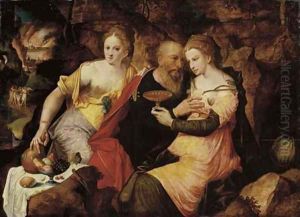The Master Of The Prodigal Paintings
The Master of the Prodigal Son is a name given to an unidentified painter or group of painters active in Antwerp during the 1530s. This notational name, like many others used in art history, was created by modern scholars to identify and categorize the work of artists whose names have been lost to time. The moniker derives from a series of paintings depicting scenes from the Parable of the Prodigal Son, a story from the New Testament of the Bible. These works are notable for their detailed representation of contemporary 16th-century life, including interiors and landscapes, as well as for their emotional depth and complexity in portraying the narrative.
The Master of the Prodigal Son's oeuvre is characterized by a keen eye for detail, a rich palette, and a dynamic composition style that suggests influence from the Northern Renaissance, particularly from artists in the Low Countries. The figures in his paintings are rendered with a strong sense of individuality and expressiveness, often set against complex backgrounds that reveal a meticulous attention to the textures and patterns of fabrics, objects, and the natural world.
Given the period in which the Master of the Prodigal Son was active, his work reflects the transitional phase between the late medieval period and the Northern Renaissance. Art historians speculate that he may have been influenced by, or even trained under, some of the leading figures of the time, such as Quentin Matsys, who brought Italianate influences into Northern art. However, without concrete documentation, these connections remain speculative.
The anonymity of the Master of the Prodigal Son is not uncommon in the study of early Renaissance art. Many artists of this period did not sign their works, and records were often inadequately kept or have been lost over time. The attribution of his paintings, therefore, relies heavily on stylistic analysis and comparison with known works of the era.
Despite the mystery surrounding his identity, the Master of the Prodigal Son's contributions to the art of the Northern Renaissance are significant. His works provide invaluable insights into the cultural, social, and religious life of 16th-century Antwerp. They also reflect the broader trends in European art of the time, including the increasing importance of landscape, the exploration of human emotion, and the integration of narrative detail. As art historians continue to study his paintings, the Master of the Prodigal Son remains an intriguing figure, representing both the talent and the enigma of early modern European art.
